Robinho: Brazilian Soccer Legend with a Tragic Ending
Robinho’s journey from the streets of São Vicente, Brazil to international football stardom represents one of the sport’s most captivating—and ultimately tragic—narratives. A player once heralded as the successor to Pelé, Robinho’s remarkable career and extraordinary talent were ultimately overshadowed by serious off-field controversies that led to his imprisonment, forever altering his legacy in the football world.

Who is Robinho?
Born Robson de Souza on January 25, 1984, in São Vicente, Brazil, Robinho emerged from humble beginnings to become one of the most talked-about footballers of his generation. His nickname “Robinho” translates to “little Robson,” a fitting moniker for a player whose diminutive stature belied his outsized impact on the pitch.
Early Fame and Style of Play
Robinho captured attention early in his career with a distinctive playing style characterized by exceptional ball control, mesmerizing dribbling skills, and astonishing technical ability. His low center of gravity, combined with lightning-quick footwork, allowed him to navigate through defenses with an ease that reminded many of his compatriots Pelé and Garrincha.
As a forward who could operate on either wing or as a second striker, Robinho’s versatility made him a valuable asset to any team. His ability to create opportunities out of seemingly impossible situations—whether through individual brilliance or by setting up teammates with precise passes—defined his playing philosophy.
Stardom in Brazil and Europe
Robinho’s rise to international prominence began in Brazil, where his performances for Santos FC caught the eyes of European scouts. His skill set translated seamlessly to European football, where he went on to represent some of the world’s most prestigious clubs, including Real Madrid, Manchester City, and AC Milan.
Throughout his career, Robinho’s flair and creativity made him a fan favorite, though his inconsistency occasionally frustrated managers and supporters alike. At his best, he was practically unstoppable—a footballing magician capable of moments of genius that few players could match.
Club Career
Started at Santos FC
Robinho’s professional journey began at Santos FC, the same club that had produced Pelé decades earlier. After joining the youth academy at age 12, he made his professional debut in 2002 at just 18 years old. Almost immediately, he established himself as one of Brazil’s most exciting prospects.
During his initial stint at Santos (2002-2005), Robinho helped the team secure the Brazilian Championship in 2002 and 2004. His performances during this period—particularly his role in the 2002 title run—earned him comparisons to Santos’s greatest legend, with some fans dubbing him “the new Pelé.”
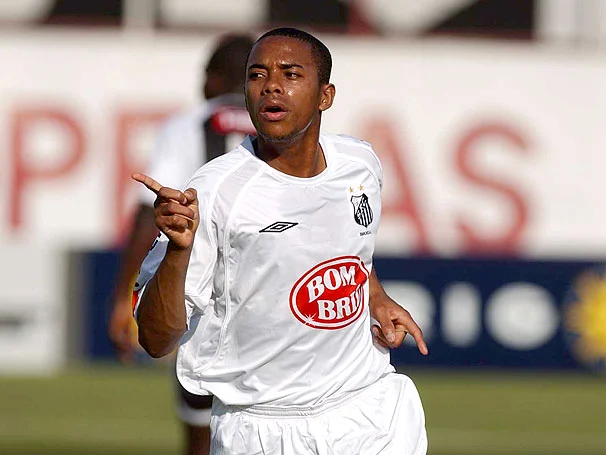
These early years showcased Robinho’s incredible potential, with spectacular goals and assists that highlighted his technical brilliance. By 2005, European giants were lining up for his signature, setting the stage for his move to one of the world’s biggest clubs.
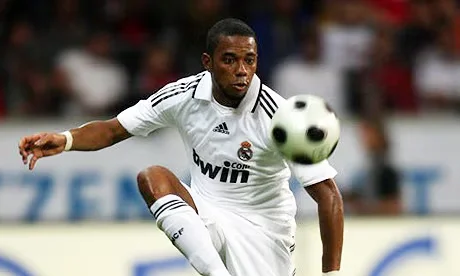
Move to Real Madrid and Success in La Liga
In 2005, Robinho made a high-profile transfer to Real Madrid for a reported €24 million. At the Santiago Bernabéu, he joined the “Galácticos” era alongside stars like Zinedine Zidane, Ronaldo, and David Beckham. The pressure of such a move might have overwhelmed many young players, but Robinho adapted quickly to Spanish football.
During his three seasons in Madrid (2005-2008), Robinho won two La Liga titles (2006-07 and 2007-08). Though his time at Real Madrid featured flashes of brilliance, some critics noted that he struggled with consistency and sometimes disappeared in crucial matches. Nevertheless, his statistics were impressive: 35 goals and numerous assists in 137 appearances across all competitions.
By 2008, changes in management and personnel at Real Madrid led to Robinho seeking a new challenge. What followed was one of the most surprising transfers in Premier League history.
Experience at Manchester City and Return to Brazil
On transfer deadline day in September 2008, Robinho became Manchester City’s record signing at £32.5 million—the first major acquisition following the club’s takeover by Abu Dhabi United Group. His arrival signaled City’s ambitions to challenge the established Premier League elite.
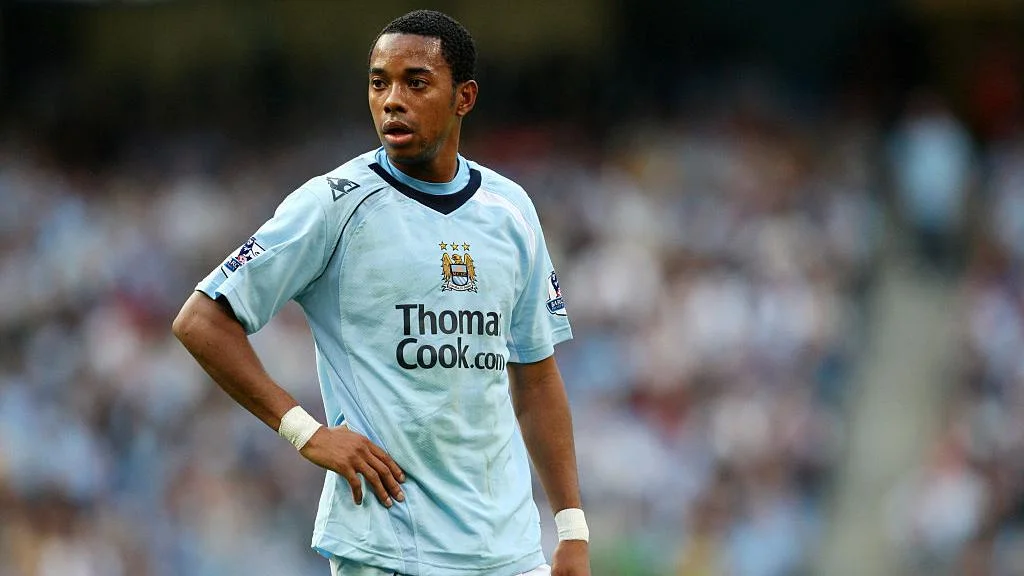
Robinho’s time at Manchester City began promisingly. He scored on his debut against Chelsea and finished his first season as the club’s top scorer with 14 Premier League goals. However, his second season saw a decline in form and playing time, with injuries and adaptation issues limiting his impact.
By January 2010, Robinho returned to Santos on a six-month loan, reconnecting with his boyhood club and Brazilian fans. This brief homecoming reinvigorated his career, with Robinho helping Santos win the Brazilian Cup and demonstrating the talent that had initially catapulted him to stardom.
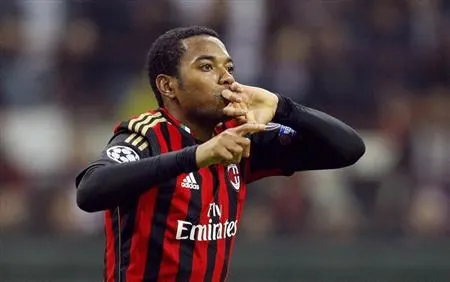
Time at AC Milan and the Final Stage of the Career
After his Manchester City experiment ended, Robinho transferred to AC Milan in August 2010 for €18 million. His four seasons at the San Siro (2010-2014) represented one of the more stable periods of his club career. At Milan, he formed a formidable attacking trio with Zlatan Ibrahimović and Alexandre Pato, helping the Rossoneri win the Serie A title in his first season (2010-11).
Robinho scored 32 goals in 144 appearances for Milan before returning to Santos for a third stint in 2014. The final phase of his career included periods at Chinese club Guangzhou Evergrande, Turkish side Sivasspor, İstanbul Başakşehir, and a brief return to Santos. His last professional engagement was with Turkish club Sivasspor in 2020, before legal issues effectively ended his playing career.
International Career
Playing for Brazil National Team
Robinho’s international career with Brazil spanned from 2003 to 2017, during which he earned 100 caps and scored 28 goals. He represented the Seleção in two World Cups (2006 and 2010) and several major tournaments, becoming a key figure in Brazil’s attacking lineup for over a decade.
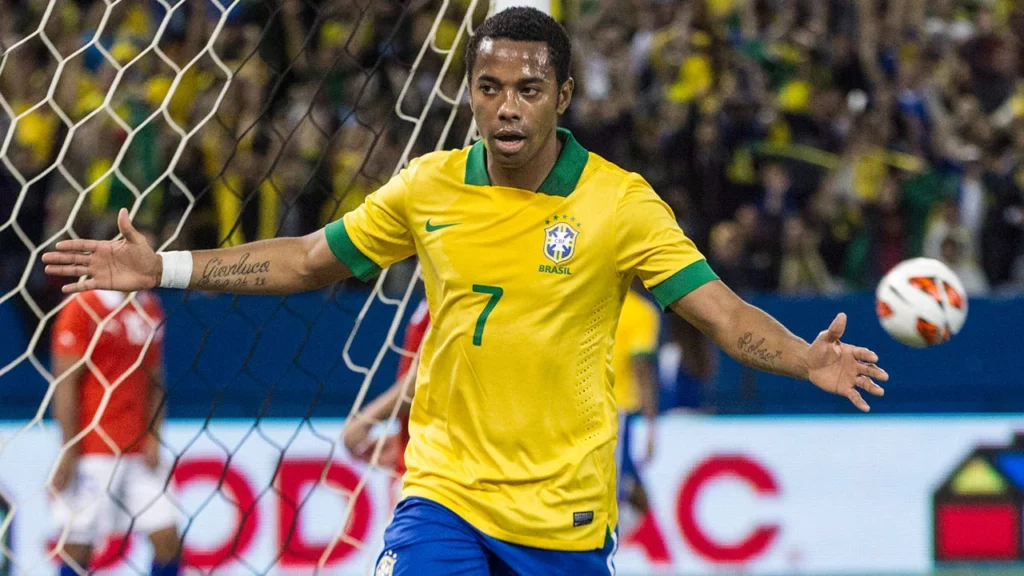
His Brazil debut came in July 2003 against Nigeria, and he quickly established himself as a regular in the national team setup. Despite his talent, Robinho’s international career coincided with a relatively fallow period for Brazilian football, which hadn’t won a World Cup since 2002.
Cups and Highlights
While World Cup success eluded Robinho, he enjoyed significant achievements in continental competitions. He played crucial roles in Brazil’s victories in the 2007 and 2009 Confederations Cups, as well as the 2007 Copa América, where he finished as the tournament’s top scorer with six goals.
Particularly memorable was his performance at the 2007 Copa América in Venezuela, where his goals and creativity helped Brazil defeat Argentina 3-0 in the final. This tournament perhaps represented the pinnacle of Robinho’s international career, showcasing his ability to dominate at the highest level when at his best.
Footballer’s Legacy
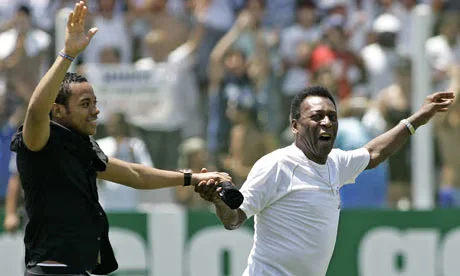
Comparisons with Pelé and Other Stars
Throughout his career, Robinho carried the burden of comparisons to Pelé—an almost impossible standard to meet. While he never reached the heights of his legendary predecessor, Robinho’s technical skills and playing style did embody elements of Brazilian football’s traditions of flair, creativity, and “jogo bonito” (beautiful game).
Among his contemporaries, Robinho was often mentioned alongside players like Ronaldinho and Kaká as representatives of Brazil’s attacking talent in the 2000s. Though he perhaps lacked the consistency of these peers, his ceiling was arguably just as high, with performances that could rival anyone’s on his best days.
Influence on Younger Generation
Robinho’s impact on younger Brazilian footballers remains significant. His dribbling techniques, feints, and ability to operate in tight spaces inspired countless young players in Brazil and beyond. Stars like Neymar have cited Robinho as an influence on their development.
The “elastico” or “flip-flap” move—a signature technique that Robinho often employed to devastating effect—became a staple in the repertoire of aspiring footballers worldwide. His playing style embodied the creative freedom and expression that many associate with Brazilian football.
Robinho After Soccer
Scandals, Arrest and Public Reaction
Robinho was accused of participating in a gang rape at a Milan nightclub in 2013. An Italian court convicted him in 2017, sentencing him to nine years in prison. In March 2023, Brazilian authorities arrested Robinho after the Brazilian Supreme Court upheld the Italian conviction.
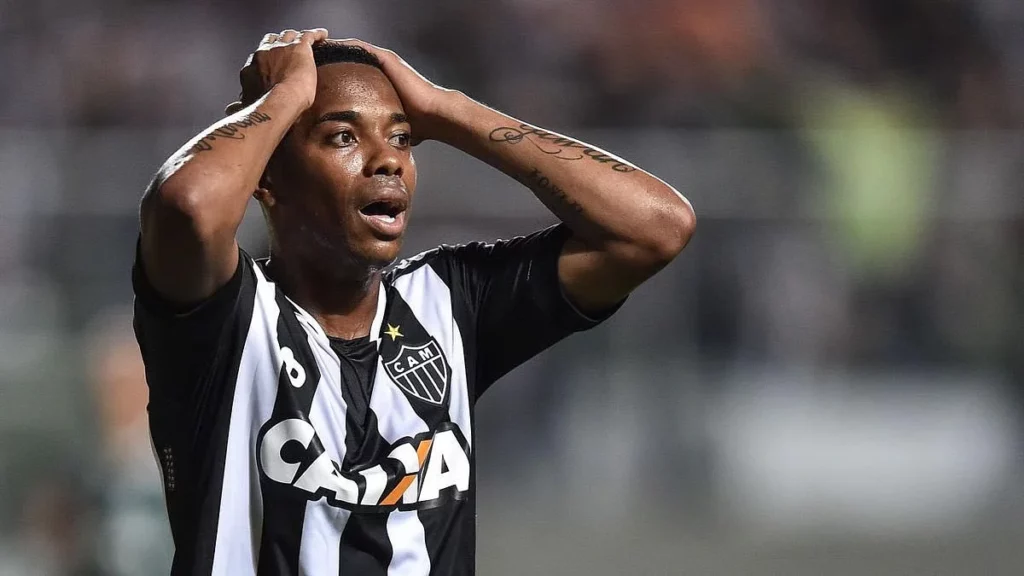
Former fans and football authorities severed ties. His fall represents one of the most dramatic downfalls in sports history. The case sparked conversations about accountability in elite sports. A story of footballing genius transformed into a cautionary tale. Robinho’s legacy exists as both talented footballer and convicted criminal. For many who watched his rise, his status serves as a reminder that sporting achievement doesn’t place anyone above the law. His career statistics—over 100 goals in European clubs and 28 for Brazil—tell of an elite performer. Yet his legacy will be defined by how it ended.